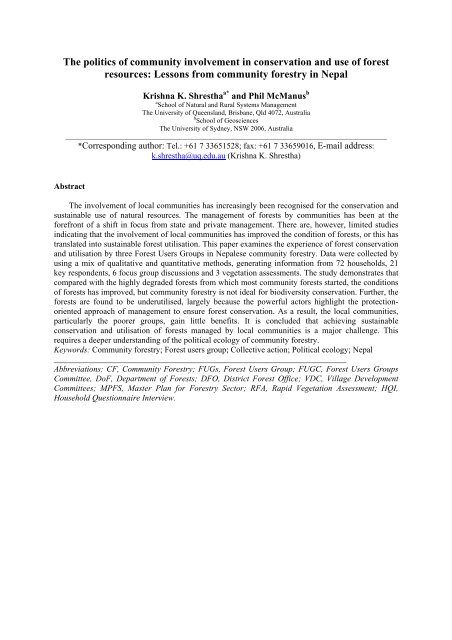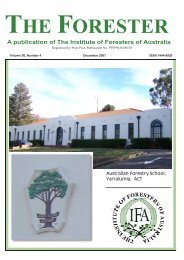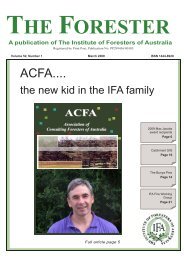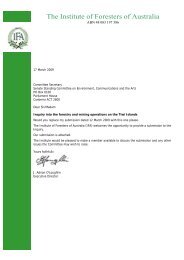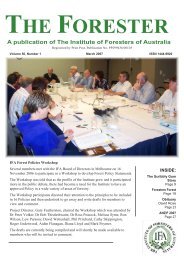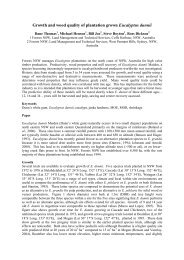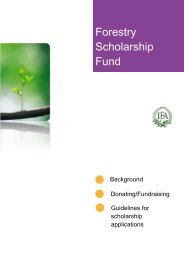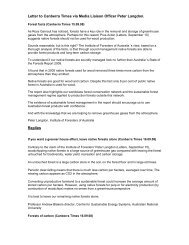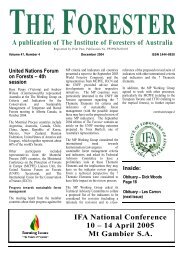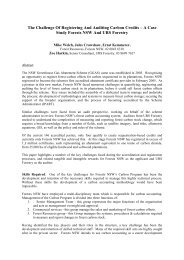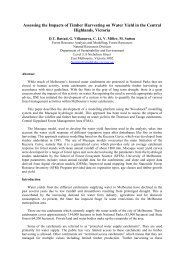Lessons from community forestry in Nepal - Institute of Foresters of ...
Lessons from community forestry in Nepal - Institute of Foresters of ...
Lessons from community forestry in Nepal - Institute of Foresters of ...
Create successful ePaper yourself
Turn your PDF publications into a flip-book with our unique Google optimized e-Paper software.
The politics <strong>of</strong> <strong>community</strong> <strong>in</strong>volvement <strong>in</strong> conservation and use <strong>of</strong> forest<br />
resources: <strong>Lessons</strong> <strong>from</strong> <strong>community</strong> <strong>forestry</strong> <strong>in</strong> <strong>Nepal</strong><br />
Krishna K. Shrestha a* and Phil McManus b<br />
a School <strong>of</strong> Natural and Rural Systems Management<br />
The University <strong>of</strong> Queensland, Brisbane, Qld 4072, Australia<br />
b School <strong>of</strong> Geosciences<br />
The University <strong>of</strong> Sydney, NSW 2006, Australia<br />
______________________________________________________________________________________________<br />
*Correspond<strong>in</strong>g author: Tel.: +61 7 33651528; fax: +61 7 33659016, E-mail address:<br />
k.shrestha@uq.edu.au (Krishna K. Shrestha)<br />
Abstract<br />
The <strong>in</strong>volvement <strong>of</strong> local communities has <strong>in</strong>creas<strong>in</strong>gly been recognised for the conservation and<br />
susta<strong>in</strong>able use <strong>of</strong> natural resources. The management <strong>of</strong> forests by communities has been at the<br />
forefront <strong>of</strong> a shift <strong>in</strong> focus <strong>from</strong> state and private management. There are, however, limited studies<br />
<strong>in</strong>dicat<strong>in</strong>g that the <strong>in</strong>volvement <strong>of</strong> local communities has improved the condition <strong>of</strong> forests, or this has<br />
translated <strong>in</strong>to susta<strong>in</strong>able forest utilisation. This paper exam<strong>in</strong>es the experience <strong>of</strong> forest conservation<br />
and utilisation by three Forest Users Groups <strong>in</strong> <strong>Nepal</strong>ese <strong>community</strong> <strong>forestry</strong>. Data were collected by<br />
us<strong>in</strong>g a mix <strong>of</strong> qualitative and quantitative methods, generat<strong>in</strong>g <strong>in</strong>formation <strong>from</strong> 72 households, 21<br />
key respondents, 6 focus group discussions and 3 vegetation assessments. The study demonstrates that<br />
compared with the highly degraded forests <strong>from</strong> which most <strong>community</strong> forests started, the conditions<br />
<strong>of</strong> forests has improved, but <strong>community</strong> <strong>forestry</strong> is not ideal for biodiversity conservation. Further, the<br />
forests are found to be underutilised, largely because the powerful actors highlight the protectionoriented<br />
approach <strong>of</strong> management to ensure forest conservation. As a result, the local communities,<br />
particularly the poorer groups, ga<strong>in</strong> little benefits. It is concluded that achiev<strong>in</strong>g susta<strong>in</strong>able<br />
conservation and utilisation <strong>of</strong> forests managed by local communities is a major challenge. This<br />
requires a deeper understand<strong>in</strong>g <strong>of</strong> the political ecology <strong>of</strong> <strong>community</strong> <strong>forestry</strong>.<br />
Keywords: Community <strong>forestry</strong>; Forest users group; Collective action; Political ecology; <strong>Nepal</strong><br />
______________________________________________________________________<br />
Abbreviations: CF, Community Forestry; FUGs, Forest Users Group; FUGC, Forest Users Groups<br />
Committee, DoF, Department <strong>of</strong> Forests; DFO, District Forest Office; VDC, Village Development<br />
Committees; MPFS, Master Plan for Forestry Sector; RFA, Rapid Vegetation Assessment; HQI,<br />
Household Questionnaire Interview.
1. Introduction<br />
The role <strong>of</strong> local communities engaged <strong>in</strong> collective action has been <strong>in</strong>creas<strong>in</strong>gly recognised as<br />
important <strong>in</strong> the conservation and susta<strong>in</strong>able utilisation <strong>of</strong> natural resources. The management <strong>of</strong> forests has<br />
been at the forefront <strong>of</strong> this shift <strong>in</strong> focus <strong>from</strong> state and private management. The active <strong>in</strong>volvement <strong>of</strong><br />
local communities <strong>in</strong> forest management and use, loosely known as Community Forestry (CF), has become<br />
one <strong>of</strong> the popular approaches for susta<strong>in</strong>able forest management. CF is particularly popular <strong>in</strong> rural sett<strong>in</strong>gs<br />
<strong>in</strong> develop<strong>in</strong>g countries, with <strong>Nepal</strong>ese CF be<strong>in</strong>g recognised as a world leader (Brown, et al., 2002; Mahanty,<br />
et al., 2006). The important role <strong>of</strong> local communities <strong>in</strong> susta<strong>in</strong>able management <strong>of</strong> forests was highlighted<br />
by the FAO’s publication, “Forestry for Local Community Development” (FAO, 1978). It was affirmed by<br />
the 1992 Earth Summit <strong>in</strong> Rio de Janeiro and reaffirmed by the 2003 World Summit on Susta<strong>in</strong>able<br />
Development <strong>in</strong> Johannesburg. The areas <strong>of</strong> forests owned or managed by communities now occupy more<br />
than 25 percent <strong>of</strong> the forest estate <strong>in</strong> develop<strong>in</strong>g countries, with the area expected to double by 2015 (Bull<br />
and White, 2002).<br />
An underly<strong>in</strong>g assumption <strong>of</strong> <strong>community</strong> <strong>in</strong>volvement <strong>in</strong> forest management is that <strong>in</strong>dividual forest<br />
users will cooperate to manage and use forest resources <strong>in</strong> a susta<strong>in</strong>able way. There are, however,<br />
contradictory explanations about collective behaviour <strong>of</strong> local people <strong>in</strong>volved <strong>in</strong> resource management. It<br />
has been argued that cooperation among self-<strong>in</strong>terested <strong>in</strong>dividuals is <strong>of</strong>ten impossible because it may<br />
actually harm <strong>in</strong>dividual <strong>in</strong>terests (Olson, 1965; Hard<strong>in</strong>, 1968). Olson (1965, p. 2) argued that “… rational<br />
self-<strong>in</strong>terested <strong>in</strong>dividuals will not act to achieve their common or group <strong>in</strong>terest”. Similarly, Hard<strong>in</strong> (1968)<br />
argued <strong>in</strong> his paper, “The Tragedy <strong>of</strong> the Commons”, that the <strong>in</strong>dividual’s rational action results <strong>in</strong><br />
collectively irrational outcomes. It was thought that when <strong>in</strong>dividuals share ownership <strong>of</strong> resources with<br />
others, they are prone to over-use those resources (Demsetz, 1967; Hard<strong>in</strong>, 1968).<br />
Respond<strong>in</strong>g to the pessimistic predictions by the “tragedy” proponents, many geographers, political<br />
scientists, anthropologists and natural resource analysts have demonstrated that many societies have devised,<br />
ma<strong>in</strong>ta<strong>in</strong>ed or adapted collective arrangements to manage natural resources for centuries (Blaikie and<br />
Brookfield, 1987; Ostrom, 1990; McCarthy, et al., 2004; Agrawal and Chhatre, 2006). These writers<br />
advocate Common Property Regimes (CPR 1 ), and argue that Hard<strong>in</strong> confused common property with open<br />
access, fail<strong>in</strong>g to dist<strong>in</strong>guish between common property and open access resources (Ciriacy-Wantrup and<br />
Bishop, 1975). The tragedy <strong>of</strong> the commons results not <strong>from</strong> the shar<strong>in</strong>g <strong>of</strong> rights, but <strong>from</strong> the absence <strong>of</strong><br />
rights. There is now a broad consensus that collective management <strong>of</strong> natural resources by their users is an<br />
appropriate system for achiev<strong>in</strong>g efficiency, equity and susta<strong>in</strong>ability.<br />
A grow<strong>in</strong>g number <strong>of</strong> critical scholars argue that the above propositions are <strong>in</strong>sufficient to expla<strong>in</strong> why<br />
<strong>in</strong>dividuals collectively act (or do not act) <strong>in</strong> the management <strong>of</strong> natural resources. A major problem lies <strong>in</strong><br />
the assumption that <strong>in</strong>dividuals are rational actors who behave <strong>in</strong> their best self-<strong>in</strong>terest to maximise material<br />
economic ga<strong>in</strong> (Petrzelka and Bell, 2000; Granovetter and Swedberg, 2001). Rather, trust, social norms and<br />
power all <strong>in</strong>fluence actions, and thereby <strong>of</strong>fset pure self-<strong>in</strong>terest (Petrzelka and Bell, 2000). Both<br />
explanations reduce humans to autonomous, pr<strong>of</strong>it maximis<strong>in</strong>g <strong>in</strong>dividuals, and that their economic<br />
behaviour can be extracted <strong>from</strong> social relations and culture (Uph<strong>of</strong>f, 1992; Fisher, 1994). Instead, collective<br />
action and resource management are better understood by analys<strong>in</strong>g them as embedded <strong>in</strong> social, economic<br />
and political situations (Mearns, 1996; McCarthy, et al., 2004). The decisions made by local communities to<br />
manage resources are highly <strong>in</strong>tegrative with the social, economic, political and ecological dynamics at<br />
various levels (Robb<strong>in</strong>s, 2004). There is now a grow<strong>in</strong>g number <strong>of</strong> calls for analys<strong>in</strong>g resource management<br />
with<strong>in</strong> the concept <strong>of</strong> embeddedness (Mosse, 1997; Cleaver, 2002; Shrestha, 2005). However, little empirical<br />
evidence exists on how and why local communities conserve and susta<strong>in</strong>ably utilise resources, and realise<br />
benefits <strong>in</strong> the context <strong>of</strong> chang<strong>in</strong>g social, economic, political and ecological circumstances.<br />
Community <strong>forestry</strong> aims at l<strong>in</strong>k<strong>in</strong>g the conservation <strong>of</strong> forest resources with the development needs <strong>of</strong><br />
rural populations (Gilmour, 1995). However, it has been reported that the conservation objectives are the<br />
focus <strong>of</strong> policies made by the state (Warner, 1997; Arnold, 2001). Current policy reforms are characterised<br />
by a transfer <strong>of</strong> extremely limited and overly specified power to local <strong>in</strong>stitutions, under tight centralgovernment<br />
oversight (Ribot, 2002). In the implementation <strong>of</strong> policies, sometimes, responsibilities and<br />
authorities are devolved to the wrong people, such as to an elite members which are, <strong>in</strong> practice, appo<strong>in</strong>tees<br />
<strong>of</strong> the central government (Fisher, 2003). In both situations - the limited devolution <strong>of</strong> power or the local<br />
1 Ostrom (1990) and Ostrom et al (1994) provide def<strong>in</strong>itions and discussions on CPR and Common Pool Resources.
elites be<strong>in</strong>g empowered – the conservation <strong>of</strong> forests is central, while the development needs <strong>of</strong> the<br />
communities are peripheral. There is a need to l<strong>in</strong>k the conservation and utilisation <strong>of</strong> forests with power and<br />
authority exercised by actors operat<strong>in</strong>g at various levels.<br />
The study presented here is an attempt to critically <strong>in</strong>vestigate the politics <strong>of</strong> <strong>community</strong> <strong>in</strong>volvement <strong>in</strong><br />
the conservation and utilisation <strong>of</strong> forests <strong>in</strong> <strong>Nepal</strong>ese CF. We do this by ask<strong>in</strong>g the follow<strong>in</strong>g research<br />
questions: What is the condition <strong>of</strong> forests managed by the local communities? What causes forest<br />
improvement (or degradation)? What are the benefits <strong>of</strong> CF, and who receives them? F<strong>in</strong>ally, why are the<br />
forests conserved and utilised <strong>in</strong> particular ways? This paper is structured as follows. In the next section, we<br />
review CF policy <strong>in</strong> <strong>Nepal</strong>, followed by some empirical evidence on the conservation and utilisation <strong>of</strong><br />
forests under <strong>Nepal</strong>ese CF. In section 3 we outl<strong>in</strong>e methodological strategy, case studies and data collection.<br />
Section 4 presents results <strong>of</strong> three case studies, highlight<strong>in</strong>g the key processes and outcomes relat<strong>in</strong>g to the<br />
conservation and utilisation <strong>of</strong> forests. In section 5 we analyse how and why the forests are conserved and<br />
utilised <strong>in</strong> particular ways and what are their implications. Section 6 concludes by summaris<strong>in</strong>g key po<strong>in</strong>ts<br />
and their theoretical, policy and practical implications.<br />
2. Community <strong>forestry</strong> <strong>in</strong> <strong>Nepal</strong><br />
Despite <strong>Nepal</strong> 2 be<strong>in</strong>g a small, landlocked k<strong>in</strong>gdom located between the giant neighbours <strong>of</strong> India and<br />
Ch<strong>in</strong>a, it has long been recognised for hav<strong>in</strong>g the world’s highest mounta<strong>in</strong>s (<strong>in</strong>clud<strong>in</strong>g Mt Everest), the<br />
birthplace <strong>of</strong> Buddha, and now, also a world leader <strong>in</strong> CF. The CF policy emerged <strong>in</strong> <strong>Nepal</strong> <strong>in</strong> the 1970s after<br />
a failure <strong>of</strong> the previous forest policy to halt deforestation, and by a realisation <strong>of</strong> the need for a forest<br />
management responsive to, and built upon, local needs and the <strong>in</strong>digenous systems. Conceptually, the change<br />
<strong>in</strong> forest policy was a paradigm shift <strong>from</strong> the state’s centralised control (top-down) to users’ decentralised<br />
control (bottom-up) (Gilmour and Fisher, 1991). In 1976, the National Forestry Plan <strong>in</strong>troduced a new<br />
policy to hand over responsibilities <strong>of</strong> forest protection and management to local political bodies. The<br />
externally supported plantation and protection-focussed forest policy did not receive much support <strong>from</strong><br />
local communities (Hobley, 1996). This changed <strong>in</strong> 1989 when the government <strong>of</strong> <strong>Nepal</strong> prepared and<br />
implemented the Master Plan for the Forestry Sector (MPFS). The needs and participation <strong>of</strong> local people<br />
were accorded a central position. The plan, which is effective until 2010, aimed at comb<strong>in</strong><strong>in</strong>g environmental<br />
objectives <strong>of</strong> protect<strong>in</strong>g land and forest resources with social and economic objectives. In 1993, the Forest<br />
Act was revised and regulations were <strong>in</strong>troduced <strong>in</strong> 1995 for the purpose <strong>of</strong> provid<strong>in</strong>g a legal framework,<br />
while operational guidel<strong>in</strong>es for the implementation <strong>of</strong> CF were provided to the field staff. The policy<br />
provided the Forest Users Groups (FUGs) with 100 percent ownership <strong>of</strong> forest products, while the entire<br />
staff <strong>of</strong> the M<strong>in</strong>istry <strong>of</strong> Forest and Soil Conservation (MFSC) are to be retra<strong>in</strong>ed for their new roles as<br />
advisors and extensionists. The MPFS aimed to transform externally imposed CF <strong>in</strong>tervention <strong>in</strong>to a<br />
<strong>community</strong> driven CF process.<br />
There have been new developments <strong>in</strong> CF policies and legislation. One key development is the<br />
amendment <strong>of</strong> Forest Act <strong>in</strong> 1998, that required FUGs to submit an annual report to the District Forest Office<br />
(DFO 3 ), describ<strong>in</strong>g the condition <strong>of</strong> the forest and the status <strong>of</strong> the fund (Kanel, 2001). The amendment<br />
empowered the DFO to penalise the FUG Committee (FUGC) and required the FUGs to spend at least 25<br />
percent <strong>of</strong> the <strong>in</strong>come on <strong>forestry</strong> development. In 2001, the government drafted the Forest Bill aimed at<br />
generat<strong>in</strong>g revenues, but the Bill was not approved by the parliament as a result <strong>of</strong> huge opposition by the<br />
general public. Despite <strong>in</strong>creas<strong>in</strong>g tensions, CF <strong>in</strong> <strong>Nepal</strong> is considered as a success. Currently, over 14,250<br />
FUGs are <strong>in</strong>volved <strong>in</strong> manag<strong>in</strong>g about 11,800 km 2 <strong>of</strong> forest land, represent<strong>in</strong>g over 20 percent <strong>of</strong> total<br />
forestland and benefit<strong>in</strong>g more than 1.6 million households (CPFD, 2006).<br />
2.1. Forest conservation and utilisation under <strong>Nepal</strong>ese Community Forestry<br />
Susta<strong>in</strong>able use and conservation <strong>of</strong> forests, and the improvement <strong>of</strong> local livelihoods are the key<br />
objectives <strong>of</strong> CF <strong>in</strong> <strong>Nepal</strong>. However, it is not well understood if both objectives are actively pursued at the<br />
2 <strong>Nepal</strong> is divided <strong>in</strong>to three physiographic regions; the Terai (59 m –610m), The Middle Hills Region (610m – 4,877m), and the<br />
Mounta<strong>in</strong>s/Himalayas (4,877m – 8848m) (see Map 1). Adm<strong>in</strong>istratively, the country is divided <strong>in</strong>to 5 development regions, 14 zones,<br />
75 districts, 58 municipalities and 3,912 Village Development Committees (VDC).<br />
3 DFO stands for District Forest Office, while DoF refers to Department <strong>of</strong> Forests. The DFO is a district branch <strong>of</strong> the DoF.
operational level. A few studies suggest that forests have been better protected by communities than by the<br />
state (Maharjan, 1998; Dev, et al., 2003). The improvement <strong>of</strong> forests is attributed to the FUGs be<strong>in</strong>g<br />
focussed on forest protection, not on utilisation. As a result, the forests are currently managed below their<br />
productive potential. However, no systematic study critically analyses the reasons and implications <strong>of</strong> the<br />
improvement <strong>in</strong> the condition <strong>of</strong> forests and the underutilisation <strong>of</strong> forest resources <strong>in</strong> <strong>Nepal</strong>ese CF.<br />
The CF processes and activities are only one <strong>of</strong> many activities for local communities. Social, economic,<br />
political and cultural activities are parts <strong>of</strong> people’s life and they <strong>in</strong>evitably <strong>in</strong>fluence CF (Night<strong>in</strong>gale, 2003;<br />
Maskey, et al., 2006; <strong>Nepal</strong>, et al., 2006). However, most analyses are narrow and simplistic <strong>in</strong> that they<br />
blame local users, population size and users’ dependence on forests as sources <strong>of</strong> problems. The historical<br />
development <strong>of</strong> CF, and the <strong>in</strong>fluence <strong>of</strong> broader political economy and unequal power relations <strong>in</strong> the<br />
decisions <strong>of</strong> the FUGs are overlooked. There is thus a need to analyse the processes and outcomes <strong>of</strong> CF as a<br />
part <strong>of</strong> systems <strong>of</strong> power and <strong>in</strong>fluence.<br />
A grow<strong>in</strong>g number <strong>of</strong> studies analyse the contribution <strong>of</strong> CF <strong>in</strong> improv<strong>in</strong>g users’ livelihoods and the<br />
distributional impacts <strong>of</strong> benefits among different groups (Dev, et al., 2003; Kanel and Niraula, 2004;<br />
Adhikari, et al., 2006). However, there are contradictions between those, who argue that local communities<br />
have received <strong>in</strong>creased and secured flows <strong>of</strong> forest products (e.g. Kanel and Niraula, 2004), and those, who<br />
argue that the benefits have been m<strong>in</strong>imal, particularly for the poorer groups (Shrestha, 2005; Luitel, 2006).<br />
Some analysts further argue that CF has worsened the livelihoods <strong>of</strong> women and poor households (Neupane,<br />
2003; Shrestha and McManus, 2005). CF scholars <strong>of</strong> <strong>Nepal</strong>ese CF seem to agree that those, who are wealthy<br />
and <strong>from</strong> higher caste (i.e. elites), capture the decision-mak<strong>in</strong>g and implementation processes, and this leads<br />
to <strong>in</strong>equitable processes and outcomes (Malla, et al., 2003; Iversen, et al., 2006). A significant lack <strong>of</strong><br />
understand<strong>in</strong>g still exists on the nature and extent <strong>of</strong> the contribution made by CF, and the causes and<br />
implications <strong>of</strong> a particular way <strong>of</strong> forest management under CF.<br />
3. Research method<br />
This research is <strong>in</strong>formed by the concepts developed with<strong>in</strong> political ecology. Political ecology is<br />
broadly def<strong>in</strong>ed as an <strong>in</strong>quiry <strong>in</strong>to ecology and broadly def<strong>in</strong>ed political economy (Blaikie and Brookfield,<br />
1978). It is also <strong>in</strong>terpreted as a research framework (Carney, 1993), and more a method <strong>of</strong> analysis than a<br />
theory (Peluso, 1992). Robb<strong>in</strong>s (2004, p.12) def<strong>in</strong>es political ecology as an “empirical, research based<br />
explorations to expla<strong>in</strong> l<strong>in</strong>kages <strong>in</strong> the condition and change <strong>of</strong> social/environmental systems, with explicit<br />
consideration <strong>of</strong> relations <strong>of</strong> power”. Political ecology is used <strong>in</strong> this study <strong>in</strong> such as way to assist <strong>in</strong> the<br />
understand<strong>in</strong>g <strong>of</strong> how are the decisions <strong>of</strong> FUGs embedded <strong>in</strong> decisions taken at various levels, how and why<br />
are certa<strong>in</strong> CF outcomes produced, and what are the key issues and the possible measures to resolve them.<br />
The study employs comparative case studies as a key research strategy. The case study <strong>of</strong>fers a method<br />
<strong>of</strong> learn<strong>in</strong>g about a complex <strong>in</strong>stance through extensive description and contextual analysis (Y<strong>in</strong>, 2002). It is<br />
a valuable method for identify<strong>in</strong>g, l<strong>in</strong>k<strong>in</strong>g and compar<strong>in</strong>g issues <strong>of</strong> resource management (Howitt, 2001).<br />
The comparison <strong>of</strong> case studies is useful to understand how local communities with specific social,<br />
economic, political and ecological situations are <strong>in</strong>fluenced by, and cope with, the changes brought about by<br />
historically chang<strong>in</strong>g socio-economic and political forces operat<strong>in</strong>g at various levels.<br />
3.1. The Selection <strong>of</strong> Study Sites<br />
A pre-fieldwork exercise was carried out as a part <strong>of</strong> research methodology to identify suitable sites for<br />
case studies. This <strong>in</strong>volved discussions with forest users, with the staff <strong>of</strong> DoF, NGOs and projects, and a<br />
review <strong>of</strong> relevant <strong>in</strong>formation. Three FUGs were selected for detailed study; Laglage Pakha FUG,<br />
Bagbhanjyang FUG and Pragatisil FUG <strong>from</strong> Kathmandu, Tanahun and Kaski districts respectively (Figure<br />
1). <strong>Nepal</strong>ese CF is <strong>in</strong>terest<strong>in</strong>g because it is large <strong>in</strong> scale, supported by legislation and <strong>of</strong>ten regarded as one<br />
<strong>of</strong> the most progressive policies implemented <strong>in</strong> one <strong>of</strong> the poorest and environmentally sensitive countries<br />
<strong>in</strong> the world. Three districts are <strong>in</strong> the mid-hill region <strong>of</strong> <strong>Nepal</strong> where CF has ma<strong>in</strong>ly been implemented.<br />
These districts are different <strong>in</strong> terms <strong>of</strong> social, economic and political contexts. They also represent the<br />
diversity <strong>of</strong> CF <strong>in</strong> terms <strong>of</strong> the stage, the number <strong>of</strong> FUGs and the issues <strong>in</strong>volved <strong>in</strong> the conservation and<br />
utilisation <strong>of</strong> forests. Three FUGs were selected on the basis <strong>of</strong> the history <strong>of</strong> collective forest management,<br />
the size <strong>of</strong> the FUGs and the forests, the present condition <strong>of</strong> forests and benefit flows to communities as<br />
perceived by the DoF staff and FUGC, the development status <strong>of</strong> FUGs and socio-economic diversity such<br />
as poverty, ethnicity and culture.
±<br />
Terai<br />
Midhills<br />
Case study districts:<br />
1<br />
2<br />
3<br />
Kathmandu<br />
Tanahun<br />
Kaski<br />
Himalaya<br />
Figure 1 Map <strong>of</strong> <strong>Nepal</strong> show<strong>in</strong>g three case study districts<br />
3<br />
2<br />
1<br />
INDIA<br />
CHINA<br />
NEPAL<br />
3.3. Data collection<br />
The research used triangulation <strong>of</strong> sources and methods to collect and analyse data so as to m<strong>in</strong>imise<br />
biases and maximise the representation <strong>of</strong> diverse sets <strong>of</strong> contextual factors. The FUG was considered as a<br />
focus for data collection <strong>in</strong> the fieldwork which was conducted between August 2001 and February 2002.<br />
The fieldwork was <strong>in</strong>fluenced by key concepts developed with<strong>in</strong> Participatory Rural Appraisal (Chambers,<br />
1994), which draws on the knowledge and skills <strong>of</strong> rural people <strong>in</strong> the analysis <strong>of</strong> their local resources and<br />
livelihoods.<br />
Data were collected <strong>from</strong> <strong>in</strong>direct and direct sources by Krishna K. Shrestha. Indirect methods were<br />
used to gather data on the history and present situation <strong>of</strong> CF <strong>from</strong> the records ma<strong>in</strong>ta<strong>in</strong>ed by the households,<br />
FUGC, and the publications <strong>of</strong> government and non-government organisations. The direct collection <strong>of</strong> data<br />
was carried out by us<strong>in</strong>g a mix <strong>of</strong> qualitative and quantitative methods. Quantitative methods such HQI<br />
(Household Questionnaire Interview) and RFA (Rapid Forest Assessment) were used to collect <strong>in</strong>formation<br />
on forests, demography and other variables. Qualitative methods, such as Semi-structured Interview (SSI),<br />
group discussions and participant observation complemented the quantitative methods.<br />
A participatory rural appraisal technique was applied to select sample households for HQI. For each<br />
FUG, a list <strong>of</strong> five FUG members were purposively selected <strong>from</strong> the overall list provided by the VDC,<br />
represent<strong>in</strong>g the, FUGC, VDC, local NGO, women and disadvantaged groups. The selected members were<br />
first given a list <strong>of</strong> all member households and asked to categorise the households <strong>in</strong>to different social,<br />
economic and ethnic groups us<strong>in</strong>g their own criteria. They grouped the households <strong>in</strong> three wealth<br />
categories; Poor, Medium and Rich, based on three socio-economic attributes: food security, land and<br />
livestock ownership and occupation. They also grouped the households <strong>in</strong> terms <strong>of</strong> ethnicity/caste <strong>in</strong> three<br />
categories; Lower Caste, Middle Caste and Higher Caste, based on the traditional system <strong>of</strong> the H<strong>in</strong>du caste<br />
hierarchy. Similarly, they grouped the households <strong>in</strong>to male-headed households and female-headed<br />
households. The f<strong>in</strong>al list was then cross-checked with other villagers for accuracy. All households (N=521)<br />
<strong>in</strong> each case study (61, 171 and 290 <strong>in</strong> first, second and third FUGs) were then divided <strong>in</strong>to different groups<br />
based on wealth rank, ethnicity and gender. For HQI, 72 (20, 23 and 29 <strong>from</strong> the case 1, 2 and 3<br />
respectively) households were selected by us<strong>in</strong>g proportional stratified random sampl<strong>in</strong>g. Household-heads<br />
were <strong>in</strong>terviewed <strong>in</strong> <strong>Nepal</strong>i language (therefore, <strong>in</strong>terviews, not household survey) by the researcher us<strong>in</strong>g a<br />
carefully designed questionnaire. Data were collected <strong>from</strong> sample households relat<strong>in</strong>g to: demography;<br />
household’s forest product needs and products received <strong>from</strong> CF; views on the past, present and future <strong>of</strong><br />
collective action; and their <strong>in</strong>volvement <strong>in</strong>, and satisfaction with, CF. The HQIs were conducted with<strong>in</strong> a<br />
workshop environment where all household members had opportunities to contribute. All data were recorded<br />
<strong>in</strong> the questionnaire and field book at the time <strong>of</strong> <strong>in</strong>terview.<br />
Of necessity, a snowball<strong>in</strong>g methodology was used to select five key respondents <strong>in</strong> each FUG for SSI,<br />
represent<strong>in</strong>g different socio-economic and ethnic groups. Respondents were asked the questions relat<strong>in</strong>g to<br />
the politics <strong>of</strong> CF, and the relationships among different stakeholders <strong>in</strong> mak<strong>in</strong>g and implement<strong>in</strong>g FUGs’
decisions. The same format <strong>of</strong> SSI was used to <strong>in</strong>terview 2 field level DFO staff <strong>in</strong> each case study site. Two<br />
group discussions, one before and one after the SSI, were organised with the 5 respondents selected for SSI,<br />
to discuss the key issues identified dur<strong>in</strong>g the HQI. The diversity <strong>of</strong> forest condition and the behaviour <strong>of</strong><br />
respondents were observed by the researcher, who lived <strong>in</strong> each FUG for four weeks. The views on the past,<br />
present and future <strong>of</strong> CF and the factors shap<strong>in</strong>g these views were <strong>in</strong>vestigated through participant<br />
observation. Each night a narrative description <strong>of</strong> the <strong>in</strong>teraction was written after return<strong>in</strong>g to the field<br />
residence.<br />
Rapid Forest Assessment (RFA) was carried out to assess the condition <strong>of</strong> forests and the potential<br />
availability <strong>of</strong> forest products. RFA is a derivative <strong>of</strong> Rapid Vegetation Assessment, which is the hybrid <strong>of</strong><br />
formal forest <strong>in</strong>ventory techniques and participatory appraisal techniques. The assessment was carried out<br />
us<strong>in</strong>g stratified random sampl<strong>in</strong>g <strong>of</strong> the forest on the basis <strong>of</strong> the types <strong>of</strong> regeneration, level <strong>of</strong> canopy and<br />
extent <strong>of</strong> harvest<strong>in</strong>g. Three rectangular plots, each <strong>of</strong> 100 m 2 , were established. The distribution <strong>of</strong> plots<br />
with<strong>in</strong> the forest was chosen <strong>in</strong> such a way to capture plantation, recently harvested sites and dense forest<br />
with mature trees, to represent the diversity <strong>of</strong> forest types. The number <strong>of</strong> seedl<strong>in</strong>gs was counted and<br />
recorded. The DBH <strong>of</strong> Sapl<strong>in</strong>gs (DBH 4 between 4 and 10cm), poles (10 to 30cm) and trees (more than 30cm)<br />
were measured and the numbers counted. Villagers and DFO field staff helped to identify species and<br />
estimate heights. The volume, density and diversity <strong>of</strong> forests were calculated, while the condition <strong>of</strong> forests<br />
was observed. Recent changes <strong>in</strong> forest conditions were discussed with respondents. All data were recorded<br />
<strong>in</strong> a field book.<br />
4. Results<br />
4.1. Case Study one: Laglage Pakha Community Forestry<br />
Laglage Pakha FUG is <strong>in</strong> Thankot VDC <strong>of</strong> Kathmandu district. It is a <strong>community</strong> <strong>of</strong> 61 households that<br />
manages 0.135 km 2 <strong>of</strong> forests. The members <strong>of</strong> the FUG are relatively homogenous with the majority<br />
belong<strong>in</strong>g to a Magar ethnic group. This group is socially cohesive with a tradition <strong>of</strong> members follow<strong>in</strong>g<br />
their ethnic leaders. The FUG members are poor and illiterate farmers who heavily depend on forests for<br />
fuelwood, fodder and timber. Despite the FUG situat<strong>in</strong>g about 10 km west <strong>of</strong> the capital, Kathmandu, the<br />
village lacks basic <strong>in</strong>frastructures such as schools, roads, electricity and dr<strong>in</strong>k<strong>in</strong>g water supply. The Prithivi<br />
Highway, which l<strong>in</strong>ks the capital to the other regions <strong>of</strong> the country, runs <strong>from</strong> the southern edge <strong>of</strong> the<br />
forest. This exposes the Laglage forest to illegal harvest<strong>in</strong>g.<br />
The reviews <strong>of</strong> publications and <strong>in</strong>terviews with respondents reveal that the forest <strong>in</strong> Laglage was<br />
heavily degraded prior to CF. In 1965, the DFO planted exotic species and implemented strict protection<br />
measures. However, forest degradation cont<strong>in</strong>ued because the ethnic leaders were not respected <strong>in</strong><br />
implement<strong>in</strong>g protection activities. With the implementation <strong>of</strong> new forest policy <strong>in</strong> 1989 and the restoration<br />
<strong>of</strong> democracy <strong>in</strong> 1990, the respondents believed that the DFO staff received the support <strong>of</strong> ethnic leaders to<br />
organise local communities <strong>in</strong>to the FUG to manage and utilise the forest. In 1993, the DFO handed over the<br />
forest as CF. The DFO <strong>of</strong> Kathmandu awarded the first prize to this FUG <strong>in</strong> 2000 (among other FUGs <strong>in</strong> the<br />
district) for its success <strong>in</strong> protect<strong>in</strong>g the forest.<br />
4.1.1. The condition <strong>of</strong> forest<br />
The RFA revealed that the condition <strong>of</strong> forests has improved <strong>in</strong> terms <strong>of</strong> the number <strong>of</strong> trees and the<br />
presence <strong>of</strong> greenery. Now, the forest is a mixed forest <strong>of</strong> hardwood and coniferous species, the former<br />
hav<strong>in</strong>g naturally regenerated and the latter established through plantation. The respondents also said that they<br />
have planted cash generat<strong>in</strong>g plants like Amriso 5 , Bamboo and Jethimadhu. The forest has a closed canopy<br />
with no evidence <strong>of</strong> soil erosion.<br />
The RFA found that the total number <strong>of</strong> stems per hectare 6 is 11,700, but the forest is still young,<br />
dom<strong>in</strong>ated by seedl<strong>in</strong>gs (59 percent) and sapl<strong>in</strong>gs (33 percent), with few poles (7 percent) and trees (0.6<br />
percent). Salla is the only tree species that was established through plantation. The forest is diverse <strong>in</strong> terms<br />
4 Diameter at breast height (DBH) is usually measured at 1.3 m <strong>in</strong> <strong>Nepal</strong>.<br />
5 All names <strong>of</strong> the trees/plants are <strong>in</strong> italics, and are local names <strong>in</strong> <strong>Nepal</strong>i. Shrestha (2005) provides all scientific names<br />
6 1 hectare = 100 km 2
<strong>of</strong> species, DBH and height. A total <strong>of</strong> 24 species were found to be present with the plant diversity <strong>in</strong>dex<br />
(PDI) <strong>of</strong> 0.07 (out <strong>of</strong> possible 1) 7 . The average crown cover percentage is 71.7, with micro-site variations <strong>in</strong><br />
slope and aspect. Analysis <strong>of</strong> the RFA data <strong>in</strong>dicates that the forest can potentially supply 77 bhari 8 <strong>of</strong><br />
foliage (exclud<strong>in</strong>g ground grass), 174 bhari <strong>of</strong> fuelwood and 1.78 m 3 <strong>of</strong> timber per hectare. If the forest is<br />
scientifically managed, it was estimated that the average annual availability <strong>of</strong> forest product for each<br />
household was 0.4 m 3 <strong>of</strong> timber, 39 bhari <strong>of</strong> fuelwood and 17 bhari <strong>of</strong> foliage.<br />
The results <strong>from</strong> participant observation, SSI, HQI and group discussions confirm the result <strong>of</strong> RFA that<br />
the condition <strong>of</strong> forest <strong>in</strong> Laglage has improved. The improvement is due to people tak<strong>in</strong>g up the<br />
responsibilities <strong>of</strong> forest protection and management. As one participant said, “who else will protect our<br />
forest, we have to do it”. Respondents were more concerned with forest protection than the utilisation<br />
because their livelihoods were affected by the degradation <strong>of</strong> forests <strong>in</strong> the past. One respondent said, “we<br />
focus on protection because we want to make sure that the forest would never be destroyed aga<strong>in</strong> as it did <strong>in</strong><br />
the past”. No sales <strong>of</strong> forest products occured, but respondents were enthusiastic about <strong>in</strong>come generation<br />
<strong>from</strong> the sale <strong>of</strong> non-timber forest products. The majority <strong>of</strong> respondents were unhappy with the DFO<br />
because it stopped provid<strong>in</strong>g f<strong>in</strong>ancial support to the FUG. The respondents <strong>from</strong> the FUGC were<br />
particularly concerned with the <strong>in</strong>stitutional barrier created by the policies and guidel<strong>in</strong>es supplied by the<br />
DFO which restricted them to make decisions accord<strong>in</strong>g to <strong>community</strong> aspirations. However, the DFO field<br />
staff argued that the policy limitations are to ensure susta<strong>in</strong>able CF and susta<strong>in</strong>able livelihoods <strong>of</strong> the<br />
communities.<br />
4.1.2. The utilisation <strong>of</strong> forest<br />
To determ<strong>in</strong>e whether the potential supply <strong>of</strong> forest products could meet the needs <strong>of</strong> the FUG,<br />
discussions were conducted with sample households dur<strong>in</strong>g the HQI. The estimated average annual<br />
household requirement was 0.32 m 3 <strong>of</strong> timber, 49.5 bhari <strong>of</strong> fuelwood, 70.5 bhari <strong>of</strong> fodder and 10.1 bhari <strong>of</strong><br />
leaf litter. The sample households suggested that they expect to meet their needs <strong>from</strong> CF. However, it was<br />
estimated that the average annual supply <strong>of</strong> forest products for each household was only 0.05 m 3 <strong>of</strong> timber,<br />
15.1 bhari <strong>of</strong> fuelwood, 14.1 bhari <strong>of</strong> fodder and 6.1 bhari <strong>of</strong> leaf litter. The households collected these<br />
products dur<strong>in</strong>g the silvicultural operations which aimed at improv<strong>in</strong>g the condition <strong>of</strong> forests. The<br />
<strong>community</strong> needs were not fulfilled.<br />
The respondents highlighted that a major reason why their needs were not met was due to forest<br />
underutilisation. Another reason that the majority <strong>of</strong> respondents suggested was the size <strong>of</strong> the forest which<br />
was small compared to the population size, and the forest has not reached the stage that could supply<br />
sufficient and suitable products to all users. The analysis <strong>of</strong> RFA data reveals that the potentially available<br />
major forest products (i.e. timber and fuelwood) for harvest<strong>in</strong>g are far greater than what is actually be<strong>in</strong>g<br />
harvested (Figure 2). The analysis <strong>of</strong> RFA data also demonstrates that the potential supply <strong>from</strong> forests can<br />
meet the timber demand, but cannot meet the fuelwood demand.<br />
The majority <strong>of</strong> respondents agreed that the decisions on the harvest<strong>in</strong>g and distribution <strong>of</strong> forest<br />
products are not driven by the <strong>community</strong> needs and products availability, but are driven by the wish <strong>of</strong> the<br />
FUGC, which <strong>in</strong> turn, are controlled by the DFO. The underutilisation <strong>of</strong> forests was a key issue among<br />
respondents. One participant said; “we have many dead trees, which can be sold, I don’t know why they are<br />
left to decay”. All respondents belong<strong>in</strong>g to the poorer and disadvantaged groups highlighted their hardships<br />
compared to other members, and argued that their survival needs are neglected by the FUGC. For example, a<br />
blacksmith said, “I can no longer get charcoal <strong>from</strong> the forest. I stopped mak<strong>in</strong>g sickles and tools … lost my<br />
major survival means. The committee does not pay attention to my needs”. A common po<strong>in</strong>t that emerged<br />
<strong>from</strong> the respondents was that the contribution <strong>of</strong> CF <strong>in</strong> improv<strong>in</strong>g users’ livelihoods has been negligible<br />
because the use <strong>of</strong> forest has not been the priority <strong>of</strong> the DFO and FUGC.<br />
4.2. Case study two: Bagbhanjyang Community Forestry<br />
Bagbhanjyang FUG is an urban <strong>community</strong> situated <strong>in</strong> Vyas Municipality <strong>of</strong> Damauli Town, which is a<br />
bus<strong>in</strong>ess centre and adm<strong>in</strong>istrative headquarter <strong>of</strong> Tanahun District. The FUG is comprised <strong>of</strong> 170<br />
households and manages 0.30 km 2 <strong>of</strong> forest situated <strong>in</strong> the northwest <strong>of</strong> the town. A large number <strong>of</strong> non-<br />
7 Shrestha (2005) provides the basis for all calculations.<br />
8 Bhari is a <strong>Nepal</strong>i term which refers to an average load <strong>of</strong> forests products that a person can carry. It is approximately 30 kg (Malla et al 2003).
FUG members live close to the forest. The <strong>in</strong>terviews with respondents reveal that the area was orig<strong>in</strong>ally<br />
<strong>in</strong>habited by <strong>in</strong>digenous groups; Daraii and Bote, but they are now displaced by bus<strong>in</strong>ess owners and<br />
adm<strong>in</strong>istrators who migrated to Damauli when the Prithivi Highway (a major l<strong>in</strong>k between Damauli and<br />
other cities) was constructed and the district headquarter relocated <strong>in</strong> 1969 <strong>from</strong> Bandipur to Damauli. The<br />
majority <strong>of</strong> FUG members are relatively wealthy bus<strong>in</strong>ess-owners who use gas energy for cook<strong>in</strong>g, and are<br />
not directly dependent on forests. Most FUG members support <strong>Nepal</strong>i Congress (a major political party <strong>in</strong><br />
<strong>Nepal</strong>) and some <strong>of</strong> the <strong>in</strong>fluential leaders are also the member <strong>of</strong> the FUG.<br />
Interviews and discussions with respondents revealed that the forest was healthy <strong>in</strong> Bagbhanjyang until<br />
it was used and managed by <strong>in</strong>digenous groups. The forest destruction started <strong>from</strong> a political decision to<br />
relocate the district headquarter to Damauli. With the relocation, local forests were extensively harvested for<br />
the construction <strong>of</strong> government <strong>of</strong>fices and private houses. The new Prithivi Highway provided an easy<br />
access for the transportation <strong>of</strong> forest products to bigger markets. Massive deforestation occurred,<br />
particularly dur<strong>in</strong>g the time <strong>of</strong> national referendum <strong>in</strong> 1980. As a response, some members <strong>of</strong> Damauli<br />
Panchayat (a local government body) organised an <strong>in</strong>formal forest protection committee <strong>in</strong> 1983 to protect<br />
the forest. The locally <strong>in</strong>itiated, elite-<strong>in</strong>spired protection committee collected money <strong>from</strong> each household<br />
and employed a forest watcher to look after the forest. The committee was recognised by the DFO <strong>in</strong> 1991<br />
after the restoration <strong>of</strong> democracy <strong>in</strong> 1990. The forest protection is cont<strong>in</strong>ued to be carried out by paid forest<br />
watchers. In 1999, the DFO <strong>of</strong> Tanahun awarded the first prize for the FUG (among others <strong>in</strong> the district) to<br />
recognise its performance <strong>of</strong> successful forest management.<br />
4.2.1. The condition <strong>of</strong> forest<br />
The RFA data reveal that the Bagbhanjyang <strong>community</strong> forest is a naturally regenerated broad-leaved<br />
forest. The forest has a vigorous regeneration and a closed canopy with a total number <strong>of</strong> stems estimated to<br />
be 18,466 per hectare. The forest is young dom<strong>in</strong>ated by seedl<strong>in</strong>gs (86 percent), sapl<strong>in</strong>gs and poles <strong>of</strong> Sal and<br />
Chilaune species. The plant diversity <strong>in</strong>dex is low at 0.04. The forest is diverse <strong>in</strong> terms <strong>of</strong> DBH, height and<br />
biomass and volume. It is estimated that the average annual forest products availability per hectare is 2.97 m 3<br />
<strong>of</strong> timber, 184 bhari <strong>of</strong> fuelwood and 64 bhari <strong>of</strong> foliage (exclud<strong>in</strong>g regeneration and ground grass). The<br />
analysis <strong>of</strong> RFA data shows that each household can receive an annual average <strong>of</strong> 0.53 m 3 <strong>of</strong> timber, 32.9<br />
bhari <strong>of</strong> fuelwood and 11.5 bhari <strong>of</strong> foliage.<br />
There was a consensus among respondents that the Bagbhanjyang forest has significantly improved<br />
through CF. One respondent said, “CF has changed the face <strong>of</strong> Bagbhanjyang. It used to be a barren land;<br />
now, it is a dense and green forest”. The majority <strong>of</strong> respondents viewed that the change <strong>in</strong> forest condition<br />
was due to the relatively effective protection achieved by forest watchers. However, some respondents were<br />
worried about the decreas<strong>in</strong>g <strong>in</strong>terest and participation <strong>of</strong> many FUG members as most members are busy <strong>in</strong><br />
bus<strong>in</strong>esses and jobs. As a result, respondents were not confident <strong>in</strong> achiev<strong>in</strong>g susta<strong>in</strong>able forest protection.<br />
They questioned the avoidance <strong>of</strong> the DFO <strong>in</strong> forest protection responsibilities. A common po<strong>in</strong>t emerged<br />
<strong>from</strong> the views <strong>of</strong> respondents was that the susta<strong>in</strong>ability <strong>of</strong> CF <strong>in</strong> Bagbhanjyang is <strong>in</strong> danger, particularly<br />
due to decreas<strong>in</strong>g participation <strong>of</strong> members, and <strong>in</strong>creas<strong>in</strong>g pressure <strong>from</strong> a huge population <strong>of</strong> nonmembers,<br />
and easy access to, and <strong>in</strong>creas<strong>in</strong>g price <strong>of</strong>, forest products <strong>in</strong> the market.<br />
4.2.2. The utilisation <strong>of</strong> forest<br />
It was estimated that each household required an average <strong>of</strong> 0.57 m 3 <strong>of</strong> timber, 17.6 bhari <strong>of</strong> fuelwood,<br />
37.4 bhari <strong>of</strong> fodder and 1.7 muttha 9 <strong>of</strong> Sal leaves <strong>from</strong> CF and other sources. Respondents suggested that<br />
almost one-third <strong>of</strong> their requirements were expected <strong>from</strong> CF. It was estimated that each household only<br />
received an average <strong>of</strong> 0.09 m 3 <strong>of</strong> timber, 5.8 bhari <strong>of</strong> fuelwood, 0 bhari <strong>of</strong> fodder and 1.7 muttha <strong>of</strong> Sal<br />
leaves per year. The extraction <strong>of</strong> these products was carried out dur<strong>in</strong>g silvicultural operations as a part <strong>of</strong><br />
improv<strong>in</strong>g forest health, which were sold to member households. The users’ needs were not fulfilled as the<br />
supply <strong>of</strong> products was far less than what was wanted. Further, the harvest<strong>in</strong>g <strong>of</strong> products was far less than<br />
what was available (i.e. underutilisation <strong>of</strong> forest). Most households use alternative fuel for cook<strong>in</strong>g, and<br />
there is an enormous surplus <strong>of</strong> fuelwood, but the forest cannot meet the high demand <strong>of</strong> timber. This is<br />
opposite to the case <strong>of</strong> Laglage Pakha FUG.<br />
9 A bundle <strong>of</strong> leaves tied by a rope and is approximately 2 kg <strong>in</strong> weight.
All respondents highlighted that the utilisation <strong>of</strong> forests <strong>in</strong> Bagbhanjyang has been m<strong>in</strong>imal. This was<br />
due to, as one respondent said, “the committee is not confident to regulate the extraction and ma<strong>in</strong>tenance <strong>of</strong><br />
forest cover”, and the other respondent argued, “the DFO discourages forest utilisation”. Respondents agreed<br />
that their dependence on forests is marg<strong>in</strong>al, but they need forests for various needs such as recreation and<br />
religious functions. The majority <strong>of</strong> respondents believed that the lack <strong>of</strong> controlled use <strong>of</strong> forest <strong>in</strong><br />
Bagbhanjyang was more <strong>in</strong>fluenced by the political leaders who were also the member <strong>of</strong> the FUG than by<br />
the DFO. As argued by many respondents, if the leaders, who wished to ma<strong>in</strong>ta<strong>in</strong> greenery for showcas<strong>in</strong>g<br />
their success to wider voters and attract<strong>in</strong>g donors, supported the generation <strong>of</strong> <strong>in</strong>come <strong>from</strong> utilis<strong>in</strong>g the<br />
forest, the DFO would not be able to oppose it.<br />
The participant observation, SSI, HQI and group discussions <strong>in</strong>dicated that peoples’ participation was<br />
ma<strong>in</strong>ly <strong>in</strong> buy<strong>in</strong>g products, <strong>in</strong> which prices were cheaper than the market price. However, some respondents<br />
compla<strong>in</strong>ed that the rate was still too high for poor users. The majority <strong>of</strong> respondents <strong>in</strong>dicated that the poor<br />
users have been unfairly penalised by this sell<strong>in</strong>g system because they are not able to purchase at auction<br />
aga<strong>in</strong>st their wealthy counterparts. All poorer and disadvantaged respondents agreed that they did not (and<br />
will not) bid at auction aga<strong>in</strong>st wealthy people because they depend on the wealthy for jobs and loans, and<br />
cannot risk their livelihood sources. Most respondents believed that the poorer households met their needs<br />
<strong>from</strong> nearby forests illegally, thus shift<strong>in</strong>g the pressure to forests elsewhere.<br />
The views <strong>of</strong> the respondents demonstrate that <strong>in</strong>come generation and <strong>community</strong> development through<br />
CF are popular, but activities on the ground are limited. Besides sell<strong>in</strong>g timber, most respondents emphasised<br />
measures such as eco-tourism and recreational use <strong>of</strong> the site to generate <strong>in</strong>come, which was also supported<br />
by the DFO.<br />
4.3. Case study 3: Pragatisil Community Forestry<br />
Pragatisil CF is located <strong>in</strong> Lekhnath Municipality <strong>of</strong> Kaski district. It manages 0.58 km 2 <strong>of</strong> broadleaved<br />
forests scattered <strong>in</strong> five patches. The Prithivi Highway runs through the forest, connect<strong>in</strong>g Pragatisil with the<br />
capital and the second biggest city <strong>of</strong> <strong>Nepal</strong>, Pokhara which is about 10 km west <strong>from</strong> Pragatisil. Pragatisil<br />
FUG is a <strong>community</strong> <strong>of</strong> 290 member households. The majority <strong>of</strong> residents are migrants who are illiterate<br />
and landless poor and <strong>of</strong> low caste groups work<strong>in</strong>g as labourers <strong>in</strong> the city. The m<strong>in</strong>orities are the traditional<br />
<strong>in</strong>habitants (Brahm<strong>in</strong> and Chettri), but they own most agricultural lands and control socio-economic and<br />
political activities <strong>of</strong> the <strong>community</strong>. The population is rapidly <strong>in</strong>creas<strong>in</strong>g because <strong>of</strong> the proximity <strong>of</strong><br />
Pragatisil to Pokhara and a relatively low value <strong>of</strong> land.<br />
The reviews <strong>of</strong> publications and <strong>in</strong>terviews with respondents reveal that the nationalisation <strong>of</strong> forests <strong>in</strong><br />
<strong>Nepal</strong> <strong>in</strong> 1957 led local people to cut trees and encroach forests quickly, fear<strong>in</strong>g <strong>from</strong> the government to lock<br />
up the forest permanently. The adm<strong>in</strong>istrative expansion <strong>of</strong> forest bureaucracy <strong>in</strong> Pokhara <strong>in</strong> 1960 and the<br />
development <strong>of</strong> roads also contributed to deforestation. By 1976, the cadastral survey clearly categorised<br />
Pragatisil as shrub-land. The northern part <strong>of</strong> the forest was less degraded than <strong>in</strong> the south because <strong>of</strong> the<br />
recognition <strong>of</strong> a H<strong>in</strong>du goddess temple, Kalika. The first plantation program was <strong>in</strong>troduced <strong>in</strong> 1976 by<br />
Queen Aishwarya <strong>in</strong> an occasion <strong>of</strong> International Women’s Day to protect the Pragatisil settlements <strong>from</strong><br />
massive flood<strong>in</strong>g. This program was not extended elsewhere, and the rapid encroachment and deforestation<br />
cont<strong>in</strong>ued. In 1978, traditional residents formed a forest protection committee to control forest encroachment<br />
and deforestation. This supra-legal committee worked well, but had to cope with frequent harassments <strong>from</strong><br />
the DFO. After the implementation <strong>of</strong> new policy <strong>in</strong> 1989, users requested the DFO to recognise the exist<strong>in</strong>g<br />
committee. The DFO imposed a new committee with an <strong>in</strong>clusion <strong>of</strong> the poorer groups, but the <strong>in</strong>fluential<br />
positions rema<strong>in</strong>ed with traditional elites. Pragatisil CF was <strong>of</strong>ficially handed over <strong>in</strong> 1993. The DFO has<br />
awarded the first prize to the FUG (among other FUGs <strong>in</strong> the district) <strong>in</strong> 2000 because the FUGC effectively<br />
protected the forests.<br />
4.3.1. The condition <strong>of</strong> forest<br />
Pragatisil <strong>community</strong> forest is a mixed broad-leaved forest, dom<strong>in</strong>ated by the naturally regenerated Sal<br />
and planted Sissoo species. The forest along the highway and close to the residential area has some open<br />
spaces. The RFA data reveals that the condition <strong>of</strong> forest has improved <strong>in</strong> terms <strong>of</strong> the number <strong>of</strong> trees and<br />
the presence <strong>of</strong> greenery, but the forest is still young, dom<strong>in</strong>ated by seedl<strong>in</strong>gs (91 percent) and poles (7<br />
percent), with few trees (0.2 percent) and sapl<strong>in</strong>gs (1.5 percent). A total <strong>of</strong> 23 species were found with<br />
grow<strong>in</strong>g stock <strong>of</strong> 18,067 stems/ha. The plant diversity <strong>in</strong>dex is low at 0.03. The crown density is 55 percent,<br />
largely attributed to 1,600 stems/ ha (exclud<strong>in</strong>g seedl<strong>in</strong>gs). The forest condition is improv<strong>in</strong>g <strong>in</strong> terms <strong>of</strong> the<br />
diversity <strong>of</strong> DBH, height, biomass and volume. Analysis <strong>of</strong> RFA data <strong>in</strong>dicates that the forest can potentially<br />
supply 24.1 bhari <strong>of</strong> foliage (exclud<strong>in</strong>g regeneration and ground grass), 83.2 bhari <strong>of</strong> fuelwood and 1.59 m 3
<strong>of</strong> timber per ha per year. If the forest is scientifically managed, it was estimated that each household can<br />
receive an average <strong>of</strong> 4.8 bhari <strong>of</strong> foliage, 16.7 bhari <strong>of</strong> fuelwood and 0.32 m 3 <strong>of</strong> timber per year.<br />
The results <strong>from</strong> the HQI, SSI, group discussions and participant observation <strong>in</strong>dicate that the forest<br />
condition has improved. As one respondent stated, “forest has improved <strong>from</strong> almost a denuded land, …<br />
users and forest watchers jo<strong>in</strong>tly look after the forest to ensure forest protection”. The majority <strong>of</strong><br />
respondents agreed that users attend meet<strong>in</strong>gs, plantation and protection activities because they receive some<br />
forest products. The participation has become a norm <strong>in</strong> which people fail<strong>in</strong>g to participate would have to<br />
face social exclusion <strong>in</strong> non-CF activities. It was found that the FUG has some critical problems because the<br />
majority <strong>of</strong> respondents are unaware as to how and why certa<strong>in</strong> rules are made and implemented.<br />
4.3.2. The utilisation <strong>of</strong> forests<br />
The estimated average annual household requirement was 0.46 m 3 <strong>of</strong> timber <strong>of</strong> timber, 42.9 bhari <strong>of</strong><br />
fuelwood, 359.3 bhari <strong>of</strong> fodder and 16.7 bhari <strong>of</strong> leaf litter. The sample households suggested that about two<br />
third <strong>of</strong> their demand is expected <strong>from</strong> CF, but the estimated average annual household supply <strong>from</strong> CF was<br />
only 0.10 m 3 <strong>of</strong> timber, 10.3 bhari <strong>of</strong> fuelwood, 14.3 bhari <strong>of</strong> fodder and 7.3 bhari <strong>of</strong> leaf litter per year. The<br />
quantities <strong>of</strong> products harvested were far less than what was needed, and what was potentially available,<br />
<strong>in</strong>dicat<strong>in</strong>g that the needs <strong>of</strong> people were not be<strong>in</strong>g fulfilled, while the forest was underutilised.<br />
The majority <strong>of</strong> respondents agreed that they receive fuelwood, grass and leaf, but the quantities <strong>of</strong><br />
products are very small portion <strong>of</strong> their actual needs. Although the distribution <strong>of</strong> products are supposedly<br />
based on equality pr<strong>in</strong>ciple, a poor teashop owner was frustrated with the product distribution rules, view<strong>in</strong>g<br />
these rules as unfair because “the poor people do not have alternatives to meet the needs, while the wealthy<br />
have a lot <strong>of</strong> private resources”. A poor woman argued; “I only need fuelwood, which is <strong>in</strong>sufficient, noth<strong>in</strong>g<br />
else. I cannot swap products with other users”. One respondent said; “the chairman <strong>of</strong> the committee makes<br />
all decisions. He is powerful; he has a support <strong>from</strong> the DFO and political parties”. The majority <strong>of</strong> poor and<br />
disadvantaged respondents highlighted that due to the strict enforcement <strong>of</strong> protection-focussed rules by the<br />
FUGC and DFO, they now receive a far less quantity <strong>of</strong> forest products compared to a situation before CF.<br />
The product harvest<strong>in</strong>g and distribution are found to have driven by the wish <strong>of</strong> the DFO, not by the<br />
collective decisions <strong>of</strong> the <strong>community</strong>. Most respondents view that the DFO is the source <strong>of</strong> power,<br />
knowledge and f<strong>in</strong>ance. A common po<strong>in</strong>t to emerge is that the DFO directly or <strong>in</strong>directly controls the ways<br />
forests are managed and used. One respondent noted that ‘the ultimate decisions on forest product harvest<strong>in</strong>g<br />
depend on the DFO ... the power comes <strong>from</strong> the ownership <strong>of</strong> land”. Overall, the respondents were unhappy<br />
with the DFO, controll<strong>in</strong>g the decisions on forest use and management at Pragatisil CF.<br />
Income generation and <strong>community</strong> development are promoted by the DFO and other agencies.<br />
However, the respondents suggested that for Pragatisil FUG, the generation <strong>of</strong> <strong>in</strong>come and <strong>community</strong><br />
development are limited and the FUG has not realised these activities <strong>in</strong> practice to the extent that they are<br />
promoted <strong>in</strong> the rhetoric. There was however a strong expectation among the respondents that the CF can<br />
generate <strong>in</strong>come.<br />
5. How and why are the forests conserved and utilised <strong>in</strong> some particular ways?<br />
5.1. The improvement <strong>of</strong> forest condition: reasons and implications<br />
The study demonstrated that the condition <strong>of</strong> forests has improved through CF. Improvement <strong>in</strong> forest<br />
condition was one <strong>of</strong> the most frequently cited statements by respondents. This study suggests that CF is<br />
revers<strong>in</strong>g degradation and regenerat<strong>in</strong>g degraded areas which are a great achievement and an endorsement<br />
for CF <strong>in</strong> <strong>Nepal</strong>. These f<strong>in</strong>d<strong>in</strong>gs are consistent with previous studies (Branny and Yadav, 1998; Yadav, et<br />
al., 2003). Then, a question emerges: what causes forest improvement?<br />
Two key reasons are revealed by this study to expla<strong>in</strong> why the forests are improved. Firstly, the FUGs<br />
have protected the forests effectively, either through direct efforts <strong>of</strong> users (<strong>in</strong> Laglage) or through forest<br />
watchers (<strong>in</strong> Bagbhanjyang), or sometimes both (<strong>in</strong> Pragatisil). Different protection systems are employed <strong>in</strong><br />
different FUGs to match up with the situations <strong>of</strong> the FUGs. These examples suggest that a uniform system<br />
previously employed by the state, if imposed on the FUGs, is less likely to be effective because the<br />
feasibility and effectiveness largely depend on the FUG’s specific socio-economic and ecological contexts.<br />
Secondly, the forests are improved because it has not been actively utilised. The harvest <strong>of</strong> forest products is<br />
far less than what is available. Underutilisation <strong>of</strong> <strong>community</strong> forests <strong>in</strong> <strong>Nepal</strong> has also been identified by<br />
previous studies (e.g. Spr<strong>in</strong>gate-Bag<strong>in</strong>ski, et al., 2003). The implication <strong>of</strong> underutilisation is that there are<br />
foregone opportunities <strong>from</strong> susta<strong>in</strong>able product harvest<strong>in</strong>g, process<strong>in</strong>g and market<strong>in</strong>g <strong>of</strong> both timber and
non-timber forest products. Current practices neglect commercial or monetary possibilities (Malla, 1993),<br />
while the subsistence focus <strong>of</strong> CF has also been compromised. If the goal <strong>of</strong> CF is to improve peoples’<br />
livelihoods, <strong>community</strong> forests should be protected and utilised accord<strong>in</strong>g to the local social, economic and<br />
ecological contexts.<br />
Some critical implications can be generated <strong>from</strong> the examples <strong>of</strong> forest conservation <strong>in</strong> three FUGs.<br />
Firstly, the improved forests means that the ability <strong>of</strong> forests to supply forest products has <strong>in</strong>creased, and thus<br />
users may be able to get more products and meet their needs. However, as this study has revealed, all three<br />
forests have not reached to the stage where they can meet the demand <strong>of</strong> timber, fuelwood and foliage for all<br />
users, even if the forests are scientifically managed and utilised. Therefore, the assumption that an improved<br />
forest will produce surplus forest products that can generate a significant level <strong>of</strong> <strong>in</strong>come for the FUGs is<br />
flawed. Time is an important variable, as is the level and manner <strong>of</strong> utilisation <strong>of</strong> forest products.<br />
Secondly, the examples <strong>of</strong> three FUGs demonstrate that they all have low species diversity, and the trees<br />
and poles are dom<strong>in</strong>ated by few species promoted by the FUGs for their particular social, economic and<br />
political values. Consider<strong>in</strong>g the <strong>in</strong>creas<strong>in</strong>gly active management <strong>of</strong> forests under CF with a specific<br />
selection <strong>of</strong> species conditioned by social, economical and political values, CF is unlikely to focus on<br />
biodiversity conservation. Therefore, <strong>community</strong> forests are not ideal for biodiversity conservation.<br />
However, given that the forests were established <strong>in</strong> degraded areas <strong>in</strong> the first place, as argued by Fisher<br />
(2000b), it should be judged <strong>in</strong> comparison to what was there before, not aga<strong>in</strong>st some theoretical ideal.<br />
Thirdly, Night<strong>in</strong>gale (2003) argued that the management <strong>of</strong> forests is associated with the historical,<br />
socio-economic and political processes. The study demonstrates that the rise <strong>of</strong> CF policy <strong>in</strong> <strong>Nepal</strong> is based<br />
on learn<strong>in</strong>g <strong>from</strong> <strong>in</strong>digenous practices, and the failure <strong>of</strong> the top-down model <strong>of</strong> forest management. The<br />
historical and field experience provided motivation for the state <strong>of</strong>ficials to work with local communities.<br />
This motivation was converted <strong>in</strong>to actions with a timely change <strong>in</strong> the political process; the restoration <strong>of</strong><br />
democracy <strong>in</strong> <strong>Nepal</strong> <strong>in</strong> 1990, and the shift <strong>in</strong> global development discourse <strong>from</strong> modernisation towards<br />
participatory development. The government <strong>of</strong> <strong>Nepal</strong> received a huge flow <strong>of</strong> <strong>in</strong>ternational grants and loans<br />
to support participatory development activities <strong>in</strong>clud<strong>in</strong>g <strong>community</strong> <strong>forestry</strong>. New forest policies were<br />
made, the staff re-tra<strong>in</strong>ed and <strong>in</strong>stitutions were promulgated to support forest users to manage forests. With<br />
legal access and secure rights over the use and management <strong>of</strong> forests, the local communities seized this<br />
opportunity to effectively protect the forests and regenerate degraded lands <strong>in</strong> a view to receive a range <strong>of</strong><br />
benefits. This implies that any attempts to improve the condition <strong>of</strong> forests at the local level should attend to<br />
the l<strong>in</strong>kages between the shap<strong>in</strong>g and mak<strong>in</strong>g <strong>of</strong> local decisions, and the chang<strong>in</strong>g historical, socio-economic<br />
and political processes at various levels.<br />
5.2. The Limited Benefits and Inequity <strong>in</strong> Community Forestry<br />
The utilisation <strong>of</strong> forests and livelihoods benefits are the fundamental elements <strong>of</strong> CF and are seen as an<br />
underly<strong>in</strong>g part <strong>of</strong> the rationale for CF. However, this study <strong>in</strong>dicates that the benefits <strong>from</strong> CF are very<br />
limited. There are examples <strong>of</strong> poor users becom<strong>in</strong>g worse <strong>of</strong>f as a result <strong>of</strong> CF. The harvest <strong>of</strong> forest<br />
products is m<strong>in</strong>imal <strong>in</strong> comparison to the <strong>in</strong>dividual users’ demand and potential availability <strong>of</strong> products.<br />
There is a huge gap between the demand and supply <strong>of</strong> forest products. This affirms the f<strong>in</strong>d<strong>in</strong>gs <strong>of</strong> Malla<br />
(2000) that contributions <strong>from</strong> CF have not been substantial. Despite the policy commitments to support<br />
livelihood benefits, much rema<strong>in</strong>s to be achieved.<br />
An important question emerges, this be<strong>in</strong>g “Why have the benefits <strong>of</strong> CF been so limited?” A simple<br />
reason for limited benefits <strong>from</strong> CF is that the forest is be<strong>in</strong>g underutilised. The FUG members do not<br />
harvest all potentially available forest products because they may be lack<strong>in</strong>g necessary knowledge, skill and<br />
confidence to use and conserve the forest <strong>in</strong> a susta<strong>in</strong>able way. However, an underly<strong>in</strong>g reason for limited<br />
benefits <strong>from</strong> CF may be that the users cannot use the forest at their will. As <strong>in</strong>dicated by the results, the<br />
politics <strong>of</strong> forest management that <strong>in</strong>volve the persistent control by the DFO to meet its conservation <strong>in</strong>terest<br />
deprive users <strong>of</strong> any real authority to harvest forest products. While there is a policy commitment to give full<br />
use rights to users, and users have some power to make decisions, these decisions are constra<strong>in</strong>ed by various<br />
rules and circulars, and by the overrid<strong>in</strong>g power <strong>of</strong> the DoF. Therefore, as Fisher (2000a) argued, the issue <strong>of</strong><br />
limited benefits <strong>from</strong> CF is based on flawed arguments because the problem is largely about the control <strong>of</strong><br />
forest resources, not about the limited flow <strong>of</strong> benefits and lack <strong>of</strong> knowledge and skills <strong>of</strong> users. There is a<br />
need for a genu<strong>in</strong>e devolution <strong>of</strong> power to local levels.<br />
The politics lead<strong>in</strong>g to underutilisation <strong>of</strong> forests <strong>in</strong> the case studies has been supported by the elite<br />
members who hold the FUGC positions and hijack the FUG agenda. Elites dictate the protectionist ways <strong>of</strong><br />
manag<strong>in</strong>g forests because they depend less on communal forests, and hence the protection focus does has<br />
little impact on them. For elites, manag<strong>in</strong>g protection is easier than manag<strong>in</strong>g controlled use. Accord<strong>in</strong>gly,
<strong>in</strong>stitutions are devised <strong>in</strong> such a way that a limited quantity <strong>of</strong> forest products is extracted, ma<strong>in</strong>ly as a part<br />
<strong>of</strong> forest improvement, not to meet users’ needs. The central issues for the elites are to m<strong>in</strong>imise use so as to<br />
ensure the protection <strong>of</strong> forests, while users’ needs and supply potential <strong>of</strong> forests are peripheral. As a result<br />
<strong>of</strong> the limited use and protection focus, most users are deprived <strong>of</strong> their basic forest product needs and are<br />
constra<strong>in</strong>ed by the rules adm<strong>in</strong>istered by the FUGC. CF may meet the conservation objectives, but only at<br />
the expense <strong>of</strong> poor users who are mostly dependent on forest products. Therefore, further devolution with<strong>in</strong><br />
the FUG is needed.<br />
A key implication <strong>of</strong> this study is that due to the absence <strong>of</strong> real devolution <strong>of</strong> decision-mak<strong>in</strong>g and<br />
limited access <strong>of</strong> forests for the FUGs, the users do not have power to demand and receive CF benefits. A<br />
reason for a lack <strong>of</strong> devolution and secure tenurial rights are the <strong>in</strong>stitutional rigidity with<strong>in</strong> the DoF and the<br />
failure <strong>of</strong> policy attention on devolution and creat<strong>in</strong>g secure rights. There have been many changes <strong>in</strong> terms<br />
<strong>of</strong> techniques <strong>of</strong> CF and tra<strong>in</strong><strong>in</strong>g provided for users, but the underly<strong>in</strong>g control structures are largely<br />
susta<strong>in</strong><strong>in</strong>g as are the lack <strong>of</strong> benefits to communities (Fisher, 2003). A fundamental cause beh<strong>in</strong>d the limited<br />
devolution and <strong>in</strong>equity <strong>in</strong> CF is that the emergence <strong>of</strong> CF has not brought about the shift <strong>in</strong> decision-mak<strong>in</strong>g<br />
assumptions underly<strong>in</strong>g the state as controller. Instead, custodial ideas <strong>of</strong> the DoF mak<strong>in</strong>g the decisions for<br />
people (<strong>of</strong>ten covertly) have simply been re<strong>in</strong>forced <strong>in</strong> the new CF policy context. The real devolution <strong>of</strong><br />
power to the local level and further devolution with<strong>in</strong> the local level can only be achieved when there is a<br />
major change <strong>in</strong> the functional, conceptual and ideological assumption about the role <strong>of</strong> state bureaucracy as<br />
a genu<strong>in</strong>e facilitator, not as a decision-maker and implementer <strong>of</strong> CF.<br />
What can br<strong>in</strong>g these fundamental changes <strong>in</strong> the state bureaucracy <strong>in</strong> <strong>Nepal</strong>? A major part <strong>of</strong> the<br />
answer lies with<strong>in</strong> the l<strong>in</strong>kage between the behaviour <strong>of</strong> the state bureaucracy and the <strong>in</strong>ternational political<br />
economy. <strong>Nepal</strong>, as one <strong>of</strong> the poorest countries <strong>in</strong> the world, depends heavily on grants and loans <strong>from</strong><br />
donors to design and implement the country’s policies. All donors do have their <strong>in</strong>terests <strong>in</strong> support<strong>in</strong>g<br />
<strong>Nepal</strong>, <strong>in</strong>clud<strong>in</strong>g promot<strong>in</strong>g democracy and fulfill<strong>in</strong>g the country’s responsibility to conserve biodiversity<br />
under the Convention on Biological Diversity. The policies <strong>of</strong> many donors are still however <strong>in</strong>formed by the<br />
environmental crisis discourse <strong>of</strong> the 1970s, which highlights the need for policy actions towards<br />
environmental conservation as a susta<strong>in</strong>able means to poverty alleviation. The state bureaucracy <strong>of</strong> <strong>Nepal</strong> has<br />
no choice. By necessity, it makes and implements the policies that make donors and <strong>in</strong>ternational<br />
communities happy. As a result, the state forest bureaucracy, attempts to devolve its responsibilities and<br />
some authority to the local level (to keep some donors happy), while at the same time, ma<strong>in</strong>ta<strong>in</strong>s its key<br />
power to ensure forest conservation (to fulfil biodiversity conservation commitment and attract more<br />
donors). The subord<strong>in</strong>ate organisations <strong>of</strong> the DoF focus on ensur<strong>in</strong>g forest conservation because their<br />
<strong>in</strong>stitutional efficiency is be<strong>in</strong>g judged <strong>in</strong> terms <strong>of</strong> the protection <strong>of</strong> forests, rather than management <strong>of</strong><br />
controlled use. In order to br<strong>in</strong>g a major change <strong>in</strong> the functional role <strong>of</strong> state bureaucracy, there is a need for<br />
major reth<strong>in</strong>k<strong>in</strong>g on how donors’ policies are <strong>in</strong>formed, made and implemented.<br />
Secondly, despite a global move for decentralisation, democracy and social justice, and the development<br />
and ref<strong>in</strong><strong>in</strong>g <strong>of</strong> many theories and concepts with<strong>in</strong> social sciences, little has been achieved <strong>in</strong> terms <strong>of</strong> a<br />
major theoretical development and ref<strong>in</strong><strong>in</strong>g <strong>of</strong> the ideological and conceptual grounds <strong>of</strong> bureaucracy that<br />
has to operate with<strong>in</strong> different social, economic and political contexts. <strong>Nepal</strong>ese bureaucracy, and many<br />
others, largely operate with the assumptions <strong>of</strong> standardised procedure, formal division <strong>of</strong> responsibility,<br />
hierarchy, and impersonal relationships. Maximis<strong>in</strong>g efficiency and public goods are still the driv<strong>in</strong>g forces<br />
<strong>of</strong> <strong>Nepal</strong>ese forest bureaucracy. In order to br<strong>in</strong>g a required change <strong>in</strong> forest conservation and utilisation, a<br />
major reth<strong>in</strong>k<strong>in</strong>g is needed <strong>in</strong> the ideological and conceptual basis <strong>of</strong> forest bureaucracy <strong>in</strong> <strong>Nepal</strong>.<br />
Alternatively, if the survival <strong>of</strong> local communities is seriously threatened, and no feasible options for<br />
efficient, equitable and susta<strong>in</strong>able resource management are absent, a massive political movement by local<br />
communities may be <strong>in</strong>evitable. This movement may not only challenge the way forest resources are be<strong>in</strong>g<br />
managed, but also the ways that the state bureaucracy and <strong>in</strong>ternational organisations are be<strong>in</strong>g operated. A<br />
deeper understand<strong>in</strong>g <strong>of</strong> the political ecology <strong>of</strong> CF is warranted to further expla<strong>in</strong> the nexus between the<br />
state and global political economy, and the local movements and the revolution <strong>in</strong> resource management.<br />
6. Conclusion<br />
This study <strong>of</strong> the utilisation and conservation <strong>of</strong> three <strong>community</strong> forests <strong>in</strong> <strong>Nepal</strong> addresses a number <strong>of</strong><br />
important debates <strong>in</strong> <strong>community</strong> <strong>forestry</strong>. The analysis shows that <strong>community</strong> forests have improved <strong>in</strong><br />
quality, but it has also shown that forests managed under CF are not ideal for biodiversity conservation. CF<br />
is revers<strong>in</strong>g degradation and regenerat<strong>in</strong>g degraded areas, however the improved forests are not at a stage to<br />
produce surplus that can be sold and generate <strong>in</strong>come. Despite CF be<strong>in</strong>g implemented based on the<br />
assumption <strong>of</strong> widespread benefits, the benefits are very limited. The limited benefits are unfairly distributed
as the needs and <strong>in</strong>terests <strong>of</strong> poor users, who are mostly dependent on forest products, are largely ignored by<br />
the DFO and local elites.<br />
In fact, the arguments <strong>of</strong> limited benefits <strong>from</strong> CF are based on flawed arguments because the problem is<br />
l<strong>in</strong>ked with the protection oriented forest management. The underutilisation <strong>of</strong> forests is shaped by the<br />
<strong>in</strong>terest <strong>of</strong> the DoF and donors to ma<strong>in</strong>ta<strong>in</strong> the forest cover. The state policies and implementation processes<br />
deprive users hav<strong>in</strong>g knowledge about, and the authority to, harvest forest products. There is an absence <strong>of</strong><br />
real devolution <strong>of</strong> decision mak<strong>in</strong>g and limited access <strong>of</strong> forests for the FUGs. Therefore, the users do not<br />
have power to demand and realise CF benefits. The powerful actors tend to blame local users lack<strong>in</strong>g<br />
knowledge, skills and capacity to actively utilise the forests. However, it is the entrenched politics at various<br />
levels and wider political economic forces that have resulted <strong>in</strong>to underutilisation <strong>of</strong> forests and <strong>in</strong>equitable<br />
processes and outcomes <strong>of</strong> CF. The conservation and utilisation <strong>of</strong> forest resources are l<strong>in</strong>ked with power<br />
and authority exercised by actors operat<strong>in</strong>g at various levels. There is a need for major reth<strong>in</strong>k<strong>in</strong>g at least <strong>in</strong><br />
two key areas: a) <strong>in</strong> the basis <strong>of</strong> donors’ policy for loans and grants for develop<strong>in</strong>g countries; b) <strong>in</strong> the<br />
functional, conceptual and ideological assumptions about the role <strong>of</strong> state bureaucracy. Otherwise, a political<br />
movement by local communities may be <strong>in</strong>evitable. A deeper understand<strong>in</strong>g <strong>of</strong> the political ecology <strong>of</strong> CF is<br />
necessary to expla<strong>in</strong> the l<strong>in</strong>kages between the management <strong>of</strong> forests and the power and authority.<br />
Despite the limited contribution <strong>of</strong> CF identified <strong>in</strong> the three case studies, the majority <strong>of</strong> users still<br />
attend meet<strong>in</strong>gs, participate <strong>in</strong> forest protection and management activities and confirm rules for a variety <strong>of</strong><br />
economic reasons such as receiv<strong>in</strong>g some benefits and anticipation <strong>of</strong> future benefits. Users’ cont<strong>in</strong>ued<br />
participation is also conditioned by non-economic reasons such as to ma<strong>in</strong>ta<strong>in</strong> social relationships and to<br />
accommodate local political considerations. This study has highlighted that the utilisation and conservation<br />
<strong>of</strong> the forests is simultaneously a matter <strong>of</strong> physical change, values, power-relationships and socio-cultural<br />
understand<strong>in</strong>gs that are specific to each location. Despite the shortcom<strong>in</strong>gs <strong>of</strong> CF identified above, it is an<br />
approach to resource management that has the potential to address these considerations. While CF is yet to<br />
be significant for meet<strong>in</strong>g needs and promot<strong>in</strong>g poverty alleviation and <strong>community</strong> development, our<br />
research has not rejected the possibilities <strong>of</strong> CF to do so. CF has an important role <strong>in</strong> <strong>Nepal</strong> and beyond, but<br />
it must be recognised that CF possibilities have been limited by the politics at various levels and by political<br />
economy. Critical assessment <strong>of</strong> CF, such as this research, is not anti-CF. It is a sympathetic, positive<br />
contribution to the exist<strong>in</strong>g understand<strong>in</strong>g <strong>of</strong> human-environment relationships for the purpose <strong>of</strong> develop<strong>in</strong>g<br />
CF.
7. References<br />
Adhikari, B., Williams, F. and Lovett, J. C., 2006. Local benefits <strong>from</strong> <strong>community</strong> forests <strong>in</strong> the middle hills<br />
<strong>of</strong> <strong>Nepal</strong>. Forest Policy and Economics, In press<br />
Agrawal, A. and Chhatre, A., 2006. Expla<strong>in</strong><strong>in</strong>g Success on the Commons: Community Forest Governance <strong>in</strong><br />
the Indian Himalaya. World Development 34, (1), 149-166.<br />
Arnold, J. E. M., 2001. Forests and People: 25 years <strong>of</strong> Community Forestry. Food and Agriculture<br />
Organization <strong>of</strong> the United Nations, Rome.<br />
Blaikie, P. and Brookfield, H., 1987. Land Degradation and Society. Methuen, London and New York.<br />
Branny, P. and Yadav, N. P., 1998. Changes <strong>in</strong> Community Forestry Condition and Management 1994-1998:<br />
Analysis <strong>of</strong> Information for the Forest Resource Assessment Study and Socio-economic Study <strong>of</strong> the<br />
Koshi Hills. <strong>Nepal</strong> UK Community Forestry Project (NUKCFP), Kathmandu.<br />
Brown, D., Malla, Y. B., Schreckenberg, K. and Spr<strong>in</strong>gate-Bag<strong>in</strong>ski, O., 2002. From Supervis<strong>in</strong>g 'Subjects'<br />
to Support<strong>in</strong>g 'Citizens': Recent Developments <strong>in</strong> Community Forestry <strong>in</strong> Asia and Africa. ODI<br />
Natural Resource Perspectives (75),<br />
Bull, G. and White, A., 2002. Global Forests <strong>in</strong> Transition: Challenges and Opportunities, <strong>in</strong>: Proceed<strong>in</strong>gs <strong>of</strong><br />
Global Perspective on Indigenous Forestry: L<strong>in</strong>k<strong>in</strong>g Communities, Commerce and Conservation,<br />
Vancouver, 4-6 June 2002.<br />
Chambers, R., 1994. Participatory Rural Appraisal (PRA): Analysis and Experience. World Development 22,<br />
(9), 1253-1268.<br />
Ciriacy-Wantrup, S. V. and Bishop, R. C., 1975. Common Property as a Concept <strong>in</strong> Natural Resources<br />
Policy. Natural Resources Journal 15, 713-727.<br />
Cleaver, F., 2002. Re<strong>in</strong>vent<strong>in</strong>g Institutions: Bricolage and the Social Embeddedness <strong>of</strong> Natural Resource<br />
Management. The European Journal <strong>of</strong> Development Research 14, (2), 11-30.<br />
CPFD, 2006. Community Forest User Group Data Base. <strong>Nepal</strong> Government, Department <strong>of</strong> Forests,<br />
Community and Private Forest Division (CPFD), Kathmandu.<br />
Demsetz, H., 1967. Toward a Theory <strong>of</strong> Property Rights. The American Economic Review 57, (2), 347-359.<br />
Dev, O. P., Yadav, N. P., Spr<strong>in</strong>gate-Bag<strong>in</strong>ski, O. and Soussan, J., 2003. Impacts <strong>of</strong> Community Forestry on<br />
Livelihoods <strong>in</strong> the Middle Hills <strong>of</strong> <strong>Nepal</strong>. Journal <strong>of</strong> Forest and Livelihoods 3, (1), 64-77.<br />
FAO, 1978. Forestry for Local Community Development. Food and Agriculture Organization <strong>of</strong> the United<br />
Nations (FAO), Rome.<br />
Fisher, R. J., 1994. Indigenous Forest Management <strong>in</strong> <strong>Nepal</strong>: Why common property is not a problem, <strong>in</strong>:<br />
Allen, M. (Eds.), Anthropology <strong>of</strong> <strong>Nepal</strong>: Peoples, Problems and Processes. Mandala Book Po<strong>in</strong>t,<br />
Kathmandu, pp. 64-81.<br />
Fisher, R. J., 2000a. Decentralization and Devolution <strong>in</strong> Forest Management: A Conceptual Overview, <strong>in</strong>:<br />
Enter, T., Victor, M. and Patrick, D. (Eds.), Decentralization and Devolution <strong>of</strong> Forest Management<br />
<strong>in</strong> Asia and the Pacific. RECOFTC (Regional Community Forestry Tra<strong>in</strong><strong>in</strong>g Centre), Bangkok, pp.<br />
3-10.<br />
Fisher, R. J., 2000b. Poverty Alleviation and Forests: Experiences <strong>from</strong> Asia, <strong>in</strong>: Forest Ecospaces,<br />
Biodiversity and Environmental Security, Amman, Jordan, 5 Oct.<br />
Fisher, R. J., 2003. Innovations, Persistence and Change: Reflections on the State <strong>of</strong> Community Forestry,<br />
<strong>in</strong>: FAO, R. a. (Eds.), Community <strong>forestry</strong>: current <strong>in</strong>novations and experiences. RECOFTC and<br />
FAO, Bangkok, pp. 16-29.<br />
Gilmour, D. A., 1995. Conservation and Development: seek<strong>in</strong>g the l<strong>in</strong>kages, <strong>in</strong>: Sandbukt, O. (Eds.),<br />
Management <strong>of</strong> Tropical Forests: towards an <strong>in</strong>tegrated perspective. Centre for Development and the<br />
Environment, Oslo, pp. 255-268.<br />
Gilmour, D. A. and Fisher, R. J., 1991. Villagers, Forests and <strong>Foresters</strong>: The Philosophy, Process and<br />
Practice <strong>of</strong> Community Forestry <strong>in</strong> <strong>Nepal</strong>. Sahayogi Press, Kathmandu.<br />
Hard<strong>in</strong>, G., 1968. The Tragedy <strong>of</strong> the Commons. Science 162, 1243-1248.<br />
Hobley, M., 1996. Participatory Forestry: The Process <strong>of</strong> Change <strong>in</strong> India and <strong>Nepal</strong>. Overseas Development<br />
<strong>Institute</strong>, London.<br />
Howitt, R., 2001. Reth<strong>in</strong>k<strong>in</strong>g Resource Management: Justice, Susta<strong>in</strong>ability and Indigenous Peoples.<br />
Routledge, London and New York.<br />
Iversen, V., Chhetry, B., Francis, P., Gurung, M., Kafle, G., Pa<strong>in</strong>, A. and Seeley, J., 2006. High value forests,<br />
hidden economies and elite capture: Evidence <strong>from</strong> forest user groups <strong>in</strong> <strong>Nepal</strong>'s Terai. Ecological<br />
Economics 58, 93-107.
Kanel, K., 2001. Forests, Collective action, and Policy Instruments <strong>in</strong> <strong>Nepal</strong>: Align<strong>in</strong>g Decentralization with<br />
Fiscal Responsibility, <strong>in</strong>: Eighth Workshop on Community Management <strong>of</strong> Forestlands, The East-<br />
West Center, Honolulu,<br />
Kanel, K. and Niraula, D. R., 2004. Can Rural Livelihoods be Improved <strong>in</strong> <strong>Nepal</strong> through Community<br />
Forestry. Banko Janakari 14, (1),<br />
Luitel, H., 2006. Do Civil Society Organizations Promote Equity <strong>in</strong> Community Forestry? A reflection <strong>from</strong><br />
<strong>Nepal</strong>'s Experience, <strong>in</strong>: Mahanty, S., Fox, J., Nurse, M., Stephen, P. and McLees, L. (Eds.), Hang<strong>in</strong>g<br />
<strong>in</strong> the Balance: Equity <strong>in</strong> Community-Based Natural Resource Management <strong>in</strong> Asia. RECOFTC and<br />
East-West Centre, Bangkok and Honolulu, pp. 122-142.<br />
Mahanty, S., Fox, J., Nurse, M., Stephen, P. and McLees, L., 2006. Hang<strong>in</strong>g <strong>in</strong> the Balance: Equity <strong>in</strong><br />
Community-Based Natural Resource Management <strong>in</strong> Asia. RECOFTC and East-West Centre,<br />
Bangkok and Honolulu.<br />
Maharjan, M., 1998. The Flow and Distribution <strong>of</strong> Costs and Benefits <strong>in</strong> the Chuliban Community Forest,<br />
Dhankuta District, <strong>Nepal</strong>. Overseas Development <strong>Institute</strong>, Rural Development Forestry Network,<br />
London.<br />
Malla, Y. B., 1993. Chang<strong>in</strong>g Role <strong>of</strong> the Forest Resource Market: An Ignored Dimension <strong>of</strong> Community<br />
Forestry. Banko Janakari 4, (1), 28-31.<br />
Malla, Y. B., 2000. Impact <strong>of</strong> Community Forestry Policy on Rural Livelihoods and Food Security <strong>in</strong> <strong>Nepal</strong>.<br />
Unasylva 51, (202),<br />
Malla, Y. B., Neupane, H. R. and Branney, P. J., 2003. Why aren't Poor People Benefit<strong>in</strong>g More <strong>from</strong><br />
Community Forestry? Journal <strong>of</strong> Forest and Livelihoods 3, (1), 78-93.<br />
Maskey, V., Gebremedh<strong>in</strong> and Dalton, T. J., 2006. Social and cultural determ<strong>in</strong>ants <strong>of</strong> collective<br />
management <strong>of</strong> <strong>community</strong> forest <strong>in</strong> <strong>Nepal</strong>. Journal <strong>of</strong> Forest Economics 11, 261-274.<br />
McCarthy, N., Dutilly-Diane, C. and Drabo, B., 2004. Cooperation, collective action and natural resource<br />
management <strong>in</strong> Burk<strong>in</strong>a Faso. Agricultural Systems 82, 233-255.<br />
Mearns, R., 1996. Community, Collective Action and Common Graz<strong>in</strong>g: The case <strong>of</strong> post-socialist<br />
Mongolia. Journal <strong>of</strong> Development Studies 32, 297-339.<br />
Mosse, D., 1997. The symbolic mak<strong>in</strong>g <strong>of</strong> a common property resource: history, ecology and locality <strong>in</strong> a<br />
tank-irrigated landscape <strong>in</strong> south India. Development and Change 28, (3), 467-504.<br />
<strong>Nepal</strong>, M., Bohara, A. K. and Barrens, R. P., 2006. Investigat<strong>in</strong>g the Impacts <strong>of</strong> Social Networks on<br />
Household Forest Conservation Effort <strong>in</strong> Rural <strong>Nepal</strong>. <strong>Nepal</strong> Study Centre, University <strong>of</strong> New<br />
Mexico, Albuquerque, New Mexico.<br />
Neupane, H. R., 2003. Contested Impact <strong>of</strong> Community Forestry on Equity: Some Evidences <strong>from</strong> <strong>Nepal</strong>.<br />
Journal <strong>of</strong> Forest and Livelihoods 2, (2), 55-61.<br />
Night<strong>in</strong>gale, A. J., 2003. Nature-Society and Development: Social, Cultural and Ecological Change <strong>in</strong> <strong>Nepal</strong>.<br />
Ge<strong>of</strong>orum 34, (4), 525-540.<br />
Olson, M., 1965. The Logic <strong>of</strong> Collective Action: Public Goods and the Theory <strong>of</strong> Groups. Cambridge<br />
University Press, Cambridge.<br />
Ostrom, E., 1990. Govern<strong>in</strong>g the Commons: The Evolution <strong>of</strong> Institutions for Collective Action. Cambridge<br />
University Press, Cambridge.<br />
Petrzelka, P. and Bell, M. M., 2000. Rationality and Solidarities: The Social Organization <strong>of</strong> Common<br />
Property Resources <strong>in</strong> the Imdrhas Valley <strong>of</strong> Morocco. Human Organization 59, (3), 343-352.<br />
Ribot, J. C., 2002. Democratic Decentralisation <strong>of</strong> Natural Resources: Institutionalis<strong>in</strong>g Popular<br />
Participation. World Resources <strong>Institute</strong>, Wash<strong>in</strong>gton, DC.<br />
Robb<strong>in</strong>s, P., 2004. Political Ecology: A Critical Introduction. Blackwell Publish<strong>in</strong>g, Oxford.<br />
Shrestha, K. K., 2005. Collective Action and Equity <strong>in</strong> <strong>Nepal</strong>ese Community Forestry. The University <strong>of</strong><br />
Sydney, Sydney.<br />
Shrestha, K. K. and McManus, P., 2005. Susta<strong>in</strong><strong>in</strong>g <strong>in</strong>equity? Reth<strong>in</strong>k<strong>in</strong>g the history <strong>of</strong> <strong>Nepal</strong>ese forest<br />
policy, <strong>in</strong>: Calver, M. (Eds.), Forest Consciousness, Proceed<strong>in</strong>gs 6th National Conference <strong>of</strong> the<br />
Australian Forest History Society. Millpress, Rotterdam, pp. 681-691.<br />
Spr<strong>in</strong>gate-Bag<strong>in</strong>ski, O., Dev, O. P., Yadav, N. P. and Soussan, J., 2003. Community Forest Management <strong>in</strong><br />
the Middle Hills <strong>of</strong> <strong>Nepal</strong>: The Chang<strong>in</strong>g Context. Journal <strong>of</strong> Forest and Livelihoods 3, (1), 5-20.<br />
Uph<strong>of</strong>f, N., 1992. Learn<strong>in</strong>g <strong>from</strong> Gal Oya: Possibilities for Participatory Development and Post-Newtonian<br />
Social Science. Cornell University Press, Ithica and London.<br />
Warner, K., 1997. The Vision and Role <strong>of</strong> Community Forestry <strong>in</strong> Susta<strong>in</strong>able Development, <strong>in</strong>: Proceed<strong>in</strong>g<br />
<strong>of</strong> the XI World Forestry Congress, Vol. 5, Section F.26: Social Dimension <strong>of</strong> Forestry's<br />
Contribution to Susta<strong>in</strong>able Development, Antalya, Turkey, 13 -22 October.
Yadav, N. P., Dev, O. P., Spr<strong>in</strong>gate-Bag<strong>in</strong>ski, O. and Soussan, J., 2003. Forest Management and Utilization<br />
under Community Forestry. Journal <strong>of</strong> Forest and Livelihoods 3, (1), 37-50.<br />
Y<strong>in</strong>, R. K., 2002. Case Study Research, Design and Methods. Sage Publications, 3rd Edition, Newbury Park.


